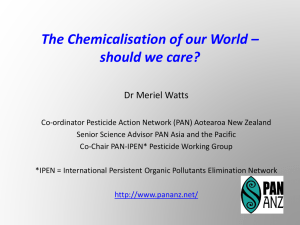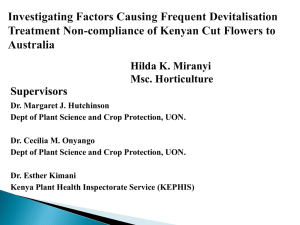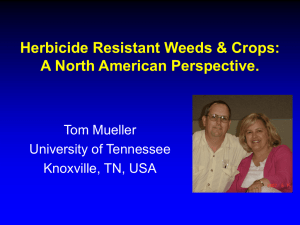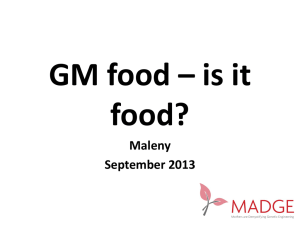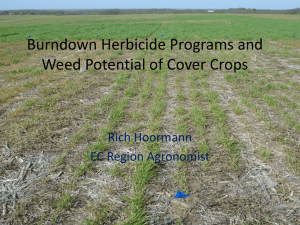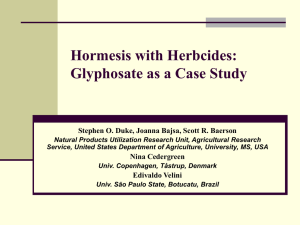Seed Round-Up - American Academy
advertisement
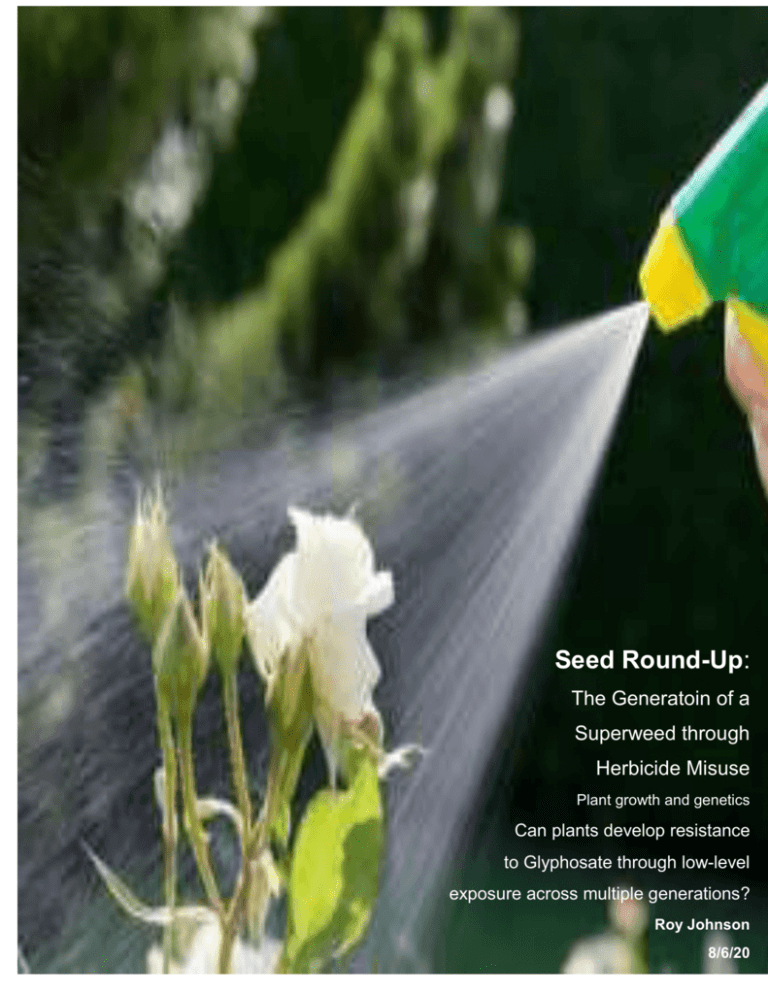
Seed Round-Up: The Generatoin of a Superweed through Herbicide Misuse Plant growth and genetics Can plants develop resistance to Glyphosate through low-level exposure across multiple generations? Roy Johnson 8/6/20 Seed Round-Up: The Geration of a Superweed through Herbicide Misuse Abstract: The use of glyphosate as an Herbicide in the United States has more than doubled in the past 30 years. In the course of this experiment Arabadopsis thaliana was used an investigational tool to track the development of herbicide resistant genes through exposure to small amounts of glyphosate at two key points in the growth cycle of A. thaliana; shortly after germination and close to the point of flower development and tracking the growth and development of the treated plants. A. thaliana seeds were placed into one of four test groups or a control group. Each group received a designated concentration of gylphosate between 1-51% or no glyphosate for the control group. Plant growth showed an inverse relatoinship to the concentration of glyphosate applied with more glyphosate leading to lower growth rates. Plants treated with low concentrations (less than 25%) of glyphosate were able to produce viable seeds which may be capable of confering resistance to glyphosate in future generational studies. Responsible use of herbicides is important to ensure that the efficacy of the chemicals does not decline with increasing genetic resistance. Introduction: Herbicides have come to have a common place in the garages and barns of both families and farmers alike. Although the use of herbicide can be a useful tool in combating weeds, the misuse or overuse of herbicide may have dramatic consequences. Through the course of this project, the ability of a plant to develop resistance to the herbicide glyphosate is tested. Using Arabadopsis thaliana as a model organism, tiered amounts of glyphosate are applied to plants during germination and flowering to examine the effects of the glyphosate on plant growth and development. This project will be continued as a longitudinal study to track the development of glyphosate resistance through minimal exposure over multiple generations. The implications of glyphosate resistance developing in the course of a few generations could render this herbicide useless in a matter of decades. Research Paper: RoundUp is a commercially available herbicide manufactured by Monsanto Corporation. The use of herbicides, in particular glyphosate has increased several fold over the past three decades (Berqkvist). Herbicides have several practical applications for commercial and residential purposes. Many farmers use herbicides to remove weeds and reduce the amount of tilling and effort in growing crops. Roundup is the brand name for the active chemical compound contained in the herbicide known as glyphosate. The chemical formula for Glyphosate is C3H8NO5P and is known by the IUPAC name N(phosphonomethyl)-glycine. When applied to plants, glyphosate is absorbed through the leaves and cuticles of the plant and is readily transported throughout the plant by phloem tissues. The result of an application of glyphosate include yellowing and wilting of the plant leaves followed by eventual plant death. The disruption of the protein synthesis pathway inhibits the production of vital aromatic amino acids necessary for plant growth (National Pesticide Information Center). Glyphosate kills plants in 4-20 days by inhibiting an enzyme vital to the plant’s protein synthesis pathway. The targeted enzyme is a part of the shikimic acid pathway known as 5-enolpyruvylshikimate-3-phosphate (EPSP) synthase. EPSP synthase is essential in the production of the three vital aromatic amino acids L-tryptophan, L-phenylalanine, and L-tyrosine. Without these essential amino acids a plant will die soon after exposure to glyphosate. Common uses for glyphosate include ornamental weed control and widespread use in crop production. Many households use glyphosate to control weed growth along driveways or in gardens. For large scale applications glyphosate is used commercially to control plant growth along roadways and railways. Many plants today have been genetically engineered to be “RoundUp Ready.” These plants have a genetic mutation which conveys resistance to the active ingredient glyphosate. With “RoundUp Ready” plants, you can “spray Roundup agricultural herbicides in-crop from emergence through flowering”(Roundup Ready System). Glyphosate can persist in soil for several days or weeks. Various studies have found half-lives ranging from 3- 130 days in soil, with an average half-life persistence of 44-60 days (Schuette). Although the toxicity of glyphosate in plants is well understood, the effect of glyphosate on animal life is still a hotly debated topic. Some studies have shown an increased risk of certain types of cancer after animals are exposed to glyphosate over long periods of time. In areas where repeated applications are common, the impact of glyphosate on animal life needs more study. To determine the capability of a plant to develop genetic resistance to glyphosate applications, Arabidopsis thaliana will be used as a model organism to track susceptibility across multiple generations. A. thaliana is widely used as a model for plant genetics due to a short generational time and the large amount of available research into the A. thaliana genome (Meinke 1998). Some plants are known to be naturally glyphosate resistance as alternate pathways for the production of the essential amino acids blocked by glyphosate have been established. The genome of A. thaliana does not naturally contain genes resistant to glyphosate. Because A. thaliana can grow from seed to flowering plant in less than six weeks it is possible to expose multiple generations to low levels of glyphosate to see if resistance can develop through multiple generations by the creation of alternate pathways for amino acid synthesis. The aromatic amino acids L-tryptophan, L-phenylalanine, and L-tyrosine are created through unique pathways in plants and are not naturally synthesized in mammals. Because the pathway to create the essential amino acids is not present in mammals it was an ideal target for herbicide development without causing harm to mammalian development (Maeda 2012). Experimental Plan: Purpose Can plants develop resistance to low level exposure to glyphosate across multiple generations? Hypothesis If Arabadopsis thaliana is exposed to low concentrations of glyphosate over multiple generations, then mutations which provide resistance to glyphosate will develop. Variables Independent Variable: Glyphosate exposure titrated to different levels Dependent Variable: Glyphosate Resistance +/- Controls: Raphanus sativus plants not exposed to glyphosate Soil, Water, Light Temperature Conditions Materials: Seed starter tray x 100 1 Liter plant pots Organic soil Arabadopsis thaliana seeds Raphanus sativus seeds Grow light Light Timer Glyphosate Gloves Goggles 5 misting sprayers Water fan Procedure: 1. Fill seed starter tray with 50g of organic soil per cup (fill 40 cups) 2. Place 1 A. thaliana seed in a cup of soil. 3. Repeat step “2” twenty (50) times. 4. Add 25mL of water to each cup containing a seed. 5. Separate seeds into groups of 10. 6. Separate each seed group with plastic walls to prevent cross pollination 7. Label Seed Groups A, B, C, D, E 8. Place seeds under grow light. 9. Turn on fan to keep plants cool and provide wind for pollination. 10. Water seeds with 25mL of water every 24 hours. 11. Allow seeds to germinate and grow for 4 days. 12. Measure and record height and condition of each plant. 13. Mix glyphosate with water to create strengths A (1%), B (10%), C (25%), D(51%) **Wear googles and gloves when handling glyphosate** 14. Apply 1 metered spray (1 ml) of solution A to each of the 10 plants in group A. 15. Repeat step 14 three times for Groups B, C, and D **Plant group E is not exposed to glyphosate.** 16. Continue to water plants every 24 hours. 17. Measure and record height and condition of each plant 24 hours after glyphosate exposure 18. Measure and record height and condition of each plant 4 days after glyphosate exposure 19. Measure and record height and condition of each plant 8 days after glyphosate exposure 20. Measure and record height and condition of each plant 12 days after glyphosate exposure 21. Measure and record height and condition of each plant 16 days after glyphosate exposure 22. Measure and record height and condition of each plant 20 days after glyphosate exposure 23. Measure and record height and condition of each plant 24 days after glyphosate exposure 24. Measure and record height and condition of each plant 28 days after glyphosate exposure 25. Carefully transfer each seed starter into a 1 liter pot. 26. Label each pot with Group A, B, C, D, or E, and type of plant. 27. Measure and record height and condition of each plant 32 days after glyphosate exposure 28. Measure and record height and condition of each plant 36 days after glyphosate exposure 29. Measure and record height and condition of each plant 40 days after glyphosate exposure 30. Apply 1 metered spray (1 mL) per plant of each strength to each group A-D 31. Measure and record height and condition of each plant 44 days after glyphosate exposure 32. Measure and record height and condition of each plant 48 days after glyphosate exposure 33. Measure and record height and condition of each plant 52 days after glyphosate exposure 34. Measure and record height and condition of each plant 56 days after glyphosate exposure 35. Measure and record height and condition of each plant 60 days after glyphosate exposure 36. Collect any seeds from plants to create F1 generation. 37. Repeat steps 1-38 for F1 generation. 38. Repeat steps 1-37 for F2 generation. 39. Compile all data. Discussion: The application of glyphosate at the standard concentration of 51% contained in commercially available herbicide RoundUp is highly effective in killing plants. One plant in the group receiving the 51% glyphosate application grew at a normal rate. It is possible that the surviving plant in the 51% group did not receive an adequate application of glyphosate or that the sprayer malfunctioned to allow this plant to survive. The plants receiving lower concentrations of glyphosate were able to grow to greater heights at an inverse relationship to the amount of glyphosate applied. Flower formation results are also similar to the results for height. The more glyphosate the plants received, the lower the percentage of plants that were able to propagate flowers. After 60 days of growth 90% of the plants in the control group receiving no glyphosate produced flowers. The plant groups receiving 1%, 10%, 25%, and 51% grew flowers at rates of 80%, 60%, 20% and 10% respectively. Seed production followed a similar trend as well. Plants receiving 1%, 10%, 25%, and 51% glyphosate produced seeds at rates of 50%, 20%, 1%, and 0%. 80% of the control group receiving no glyphosate were able to produce flowers. The collected seeds will be used to create the F1 generation to follow for development of genetic resistance to glyphosate. 1 plant in the 25% glyphosate group did not sprout and affected the average recorded height. The un-sprouted seed was likely not affected by the application of glyphosate and was simply a bad seed. The effect of glyphosate of the plants was also seen in the appearance of the leaves following application. Glyphosate was applied to the plants 4 days after planting and 40 days after planting. The first application of glyphosate stunted the growth of the plants in proportion to the concentration of glyphosate used. In plants that were surviving but growing weakly following the first application, the second application of glyphosate on day 40 was effective in causing death in the majority of the weakened plants. Plant death was evident as the leaves of the plant changed colors from green to yellow then brown, and turgidity of the leaves changed from firm to weak to wilted. The development of glyphosate resistance is a concern for commercial and residential applications of herbicide. In the United States there are >40 species of weeds that are known to be glyphosate resistant. As the use of glyphosate continues to increase, more plant species will be inadvertently exposed to low levels through misuse or overuse. Although the lower concentrations may not be fatal to the plant, the possible genetically resistant weeds that may develop have far graver consequences. Future studies will follow the seeds obtained through a similar course to track the development of glyphosate resistance. Conclusion: At high concentrations glyphosate is highly toxic to plants. Lower concentrations of glyphosate below 25% allow for flower production in a majority of plants. The creation of seeds in plants treated with glyphosate, even at low levels, occurs at 50% of normal levels. The seeds obtained from plants exposed to glyphosate may or may not contain mutations which confer resistance to glyphosate. Further study is needed to track A. thaliana’s ability to survive higher concentrations of glyphosate. In plants that display resistance, DNA sequencing can be performed to confirm if mutations have occurred in the ESRB gene to confer resistance to glyphosate. Acknowledgements: I would like to give a special thanks to Amanda Lane-Cline for inspiring this project. Recognition is also due to my wife Kate for her support and help in collecting data. Works Cited National Pesticide Information Center. Oregon State University, USEPA. September 2010. 4 August 2014. <http://npic.orst.edu/factsheets/glyphotech.html>. Roundup Ready System. Monsanto. 2014. 4 August 2014. <http://www.monsanto.com/weedmanagement/pages/roundup-ready-system.aspx>. Schuette, Jeff. “ENVIRONMENTAL FATE OF GLYPHOSATE”. California Department of Pesticide Regulation, Environmental Monitoring and Pest Management. November 1998. Meinke, David; et. Al. “Arabidopsis thaliana: A Model Plant for Genome Analysis.” SCIENCE. VOL 282 23 OCTOBER 1998. 681. Maeda H, Dudareva N. “The shikimate pathway and aromatic amino Acid biosynthesis in plants.” Annual Review of Plant Biology. 2012. Nandula, VK; et. Al. “Glyphosate-resistant and –susceptible soybean (Glycine max) and canola (Brassica napus) dose response and metabolism relationships with glyphosate”. Journal of Agricultural Food Chemistry. May 2 2007. 3540-5. Peter Bergkvist. KEMI Swedish Chemicals Agency 12/15/2011. <http://www.kemi.se/en/Content/Statistics/Statistics-in-brief/Statistics-in-brief--Substances-and-substance-groups/Glyphosate/>. August 5, 2014

